- Otis tarda
Identification
105 cm (41¾ in)
Breeding male
- Back barred black and gold
- Broad white patch on the wing
Distribution
Southern Palearctic, southeastern Russia to Mongolia and northeastern China.
A re-introduction programme has been started in the UK, based on Salisbury Plain in Wiltshire.
Taxonomy
Subspecies
There are 2 subspecies1:
- O. t. tarda:
- Southern Palearctic
- O. t. dybowskii:
Habitat
cereal croplands, open plains and steppe, grassland.
Behaviour
Diet
Their diet is mainly plant based, but they also eat invertebrates, small animals and nesting birds too.
Breeding
They nest on the ground, sometimes making a scrape which is occasionally lined with pieces of grass.
Vocalisation
<flashmp3>Otis tarda (song).mp3</flashmp3>
Gallery
Click on photo for larger image
Photo © by bengtfalke
Belen plains, Extremadura, Spain, April 2009
References
- Clements, J. F., T. S. Schulenberg, M. J. Iliff, S. M. Billerman, T. A. Fredericks, B. L. Sullivan, and C. L. Wood. 2019. The eBird/Clements Checklist of Birds of the World: v2019. Downloaded from http://www.birds.cornell.edu/clementschecklist/download/
- Handbook of the Birds of the World Alive (retrieved May 2017)
- Birdforum Member observations
Recommended Citation
- BirdForum Opus contributors. (2025) Great Bustard. In: BirdForum, the forum for wild birds and birding. Retrieved 3 May 2025 from https://www.birdforum.net/opus/Great_Bustard







